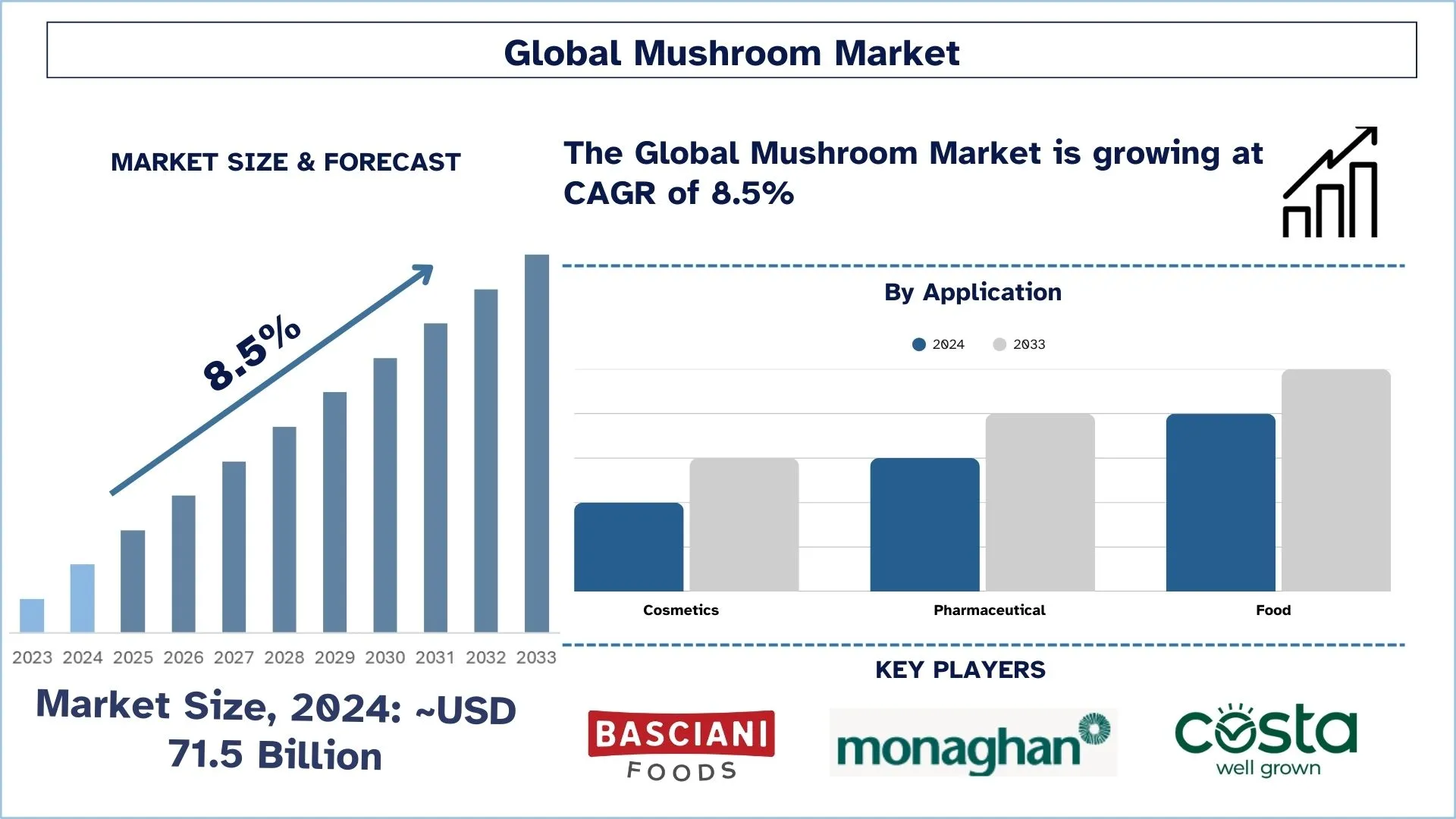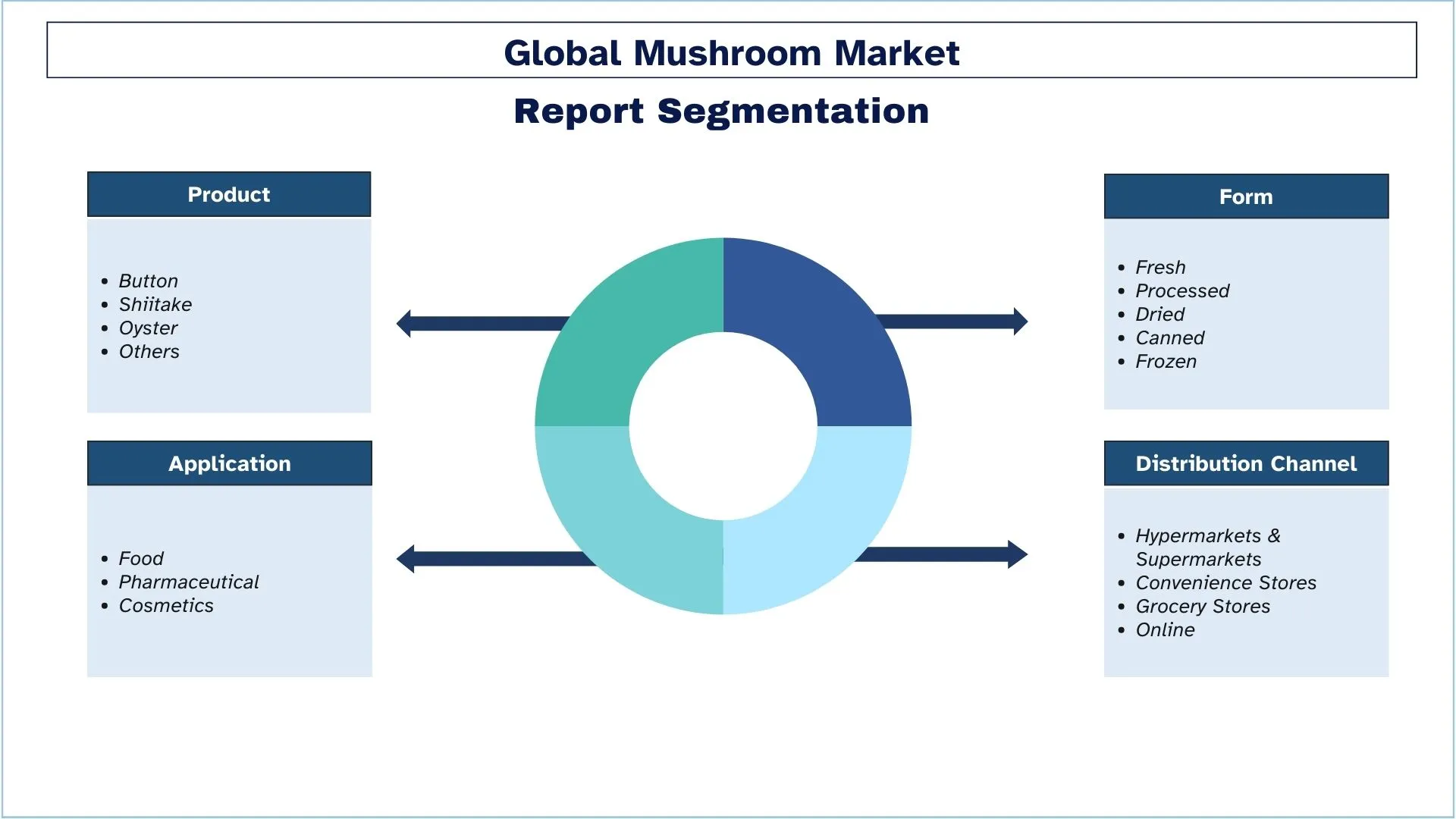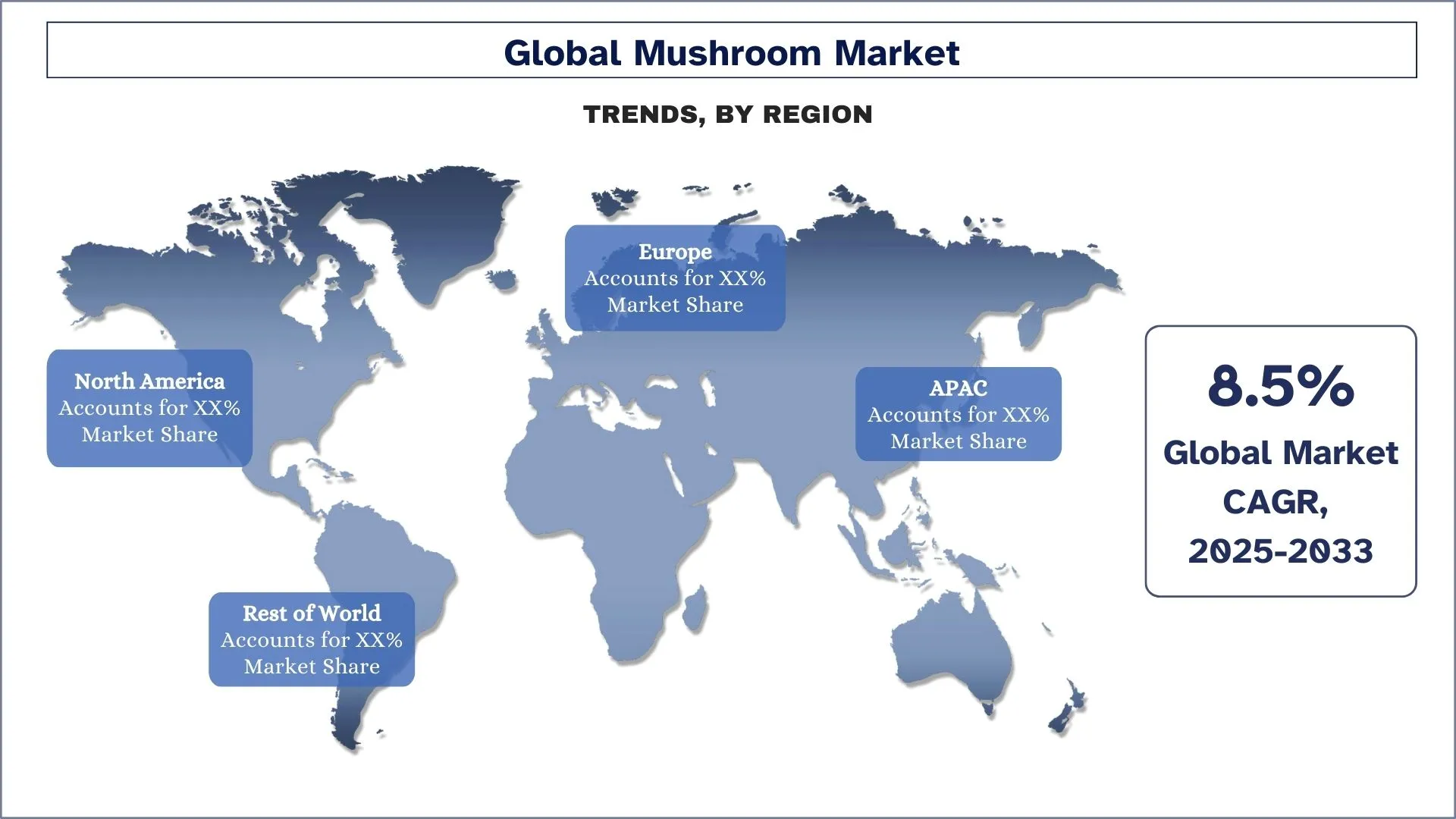- Home
- About Us
- Industry
- Services
- Reading
- Contact Us
Mushroom Market: Current Analysis and Forecast (2025-2033)
Emphasis on Product Type (Button, Shiitake, Oyster, Others); Form (Fresh, Processed); Application (Food, Pharmaceutical, Cosmetics); Distribution Channel Type (Hypermarkets & Supermarkets, Convenience Stores, Grocery Stores, Online); Region/Country

Mushroom Market Size & Forecast
The mushroom market was valued at approximately USD 71.5 billion in 2024 and is expected to grow at a substantial CAGR of around 8.5% during the forecast period (2025-2033), owing to the rising demand for plant-based foods.
Mushroom Market Analysis
A mushroom is an umbrella-shaped fruiting body of a certain macro-fungal group that is fleshy and nutrient-rich. They can appear above or below the ground and are edible as they provide a strong umami flavor and several health benefits. The deficiency and inadequacy of micronutrients constitute a global health issue. Despite the abundant sunshine present in many countries across the globe, there has been a rise in the number of people with vitamin D deficiency owing to the lack of food fortified with, vitamin D. Owing to these facts and the increase in health-conscious population, there has been growing demand for mushrooms among the consumers as mushrooms contain Vitamin D and have the ability to synthesize it when exposed to UV light or sunlight exposure.
Furthermore, the rising demand for clean-label cosmetics and growing consumer awareness regarding product formulation and ingredients are gaining significant traction in the market. Therefore, many beauty & personal care product manufacturers are increasingly using plant-based ingredients while formulating their products, which in turn is expected to have a positive impact on the demand for mushrooms. Mushrooms are incredibly adaptable; they are delicious sauteed, can be used to create vegan leather, and can even be included in healthcare products. One of the most fascinating inhabitants of Earth is mushrooms, which differ from plants and animals by their distinctive molecular makeup and growth habits. Also, the different varieties of mushrooms can provide unique beauty benefits, which have been touted by many skincare experts. For example, the Shiitake mushroom, one of the most readily eaten mushrooms, is rich in kojic acid and helps to brighten the skin, fade dark spots and acne scars, and treat hyperpigmentation.
Mushroom Market Trends
This section discusses the key market trends influencing the various segments of the Mushroom Market as identified by our research experts.
Rising Popularity of Functional Mushrooms in Health and Wellness Products
The mushroom market experiences active growth from consumers seeking functional mushrooms, including reishi and lion's mane and chaga, and cordyceps, because of increasing interest in natural wellness and preventive healthcare. The increased adoption of mushrooms occurs through supplements together with teas and powders, which then get incorporated into functional beverages because of their dual adaptogenic and immune-beneficial characteristics. Natural remedies that substitute synthetic pharmaceuticals gain popularity because consumers appreciate their benefits, which include improved mental functions as well as stress management and slowing down aging processes. Both startups and established food & nutraceutical brands introduce mushroom-infused products because of the growing clean-label product and holistic health practice popularity.
Mushroom Industry Segmentation
This section provides an analysis of the key trends in each segment of the global mushroom market report, along with forecasts at the global, regional, and country levels for 2025-2033.
The Button Mushroom Market Holds the Largest Share of the Mushroom Market.
Based on product, the market is segmented into button, shiitake, oyster, and others. The button mushroom dominated the mushroom market and is expected to grow at a considerable CAGR during the upcoming years, as it is one of the most popular varieties of mushrooms that is consumed and produced regularly all over the world. For instance, the national annual production of mushrooms in India is estimated to be approximately. 50,000 tonnes with almost 85% of this production being of a button mushroom.
The Fresh Segment is Expected to Witness a Higher CAGR than the Mushroom Market.
Based on the form, the mushroom market has been bifurcated into fresh, processed, dried, canned, and frozen. The fresh segment is expected to garner the major market share in 2024 and will grow at a remarkable CAGR. This is mainly owing to the high demand for fresh mushrooms as they are more nutritious as compared to the other ones. Fresh white mushrooms are rich in riboflavin, niacin, copper, pantothenic acid, and selenium. Additionally, the increase in the number of consumers who are inclined towards healthier food options with no added preservatives is also propelling the growth of the market.

North America has a significant share of the market in 2024.
North America is one of the largest markets for mushroom markets in 2022. The region shows growth potential because of the product’s rapidly expanding demand, which is linked to its numerous health benefits. To improve their production capacity and maintain their leadership in the local market, prominent market players in North America are implementing cutting-edge cultivation techniques as well as a variety of merger and acquisition strategies. Additionally, the government’s assistance in accelerating harvesting speeds contributes to growth. For instance, the National Institute of Food and Agriculture of the U.S. Department of Agriculture awarded about USD 4 million to the College of Agricultural Sciences at Pennsylvania State University in September 2021 to support a group of researchers as they investigate technologies to address labor shortages on farms that cultivate edible fungi.
U.S. Dominates the North American Mushroom Market
The mushroom industry in the United States demonstrates rapid expansion because customers increasingly seek plant-based products with high nutritional value. The culinary world accepts mushrooms as a flexible component that matches rising health-aware eating tendencies. Customers are rapidly increasing their consumption of processed mushroom items, which include canned and dried, and frozen varieties intended for the convenience food market. The market is expanding because of the rising interest among consumers toward functional mushrooms that offer health benefits and their known potential advantages. The industry expands because of improved cultivation methods and supply chain logistics systems that create conditions for mushrooms to become standard food items in American households.

Mushroom Industry Competitive Landscape
The mushroom market is competitive, with several global and international players. The key players are adopting different growth strategies to enhance their market presence, such as partnerships, agreements, collaborations, new product launches, geographical expansions, and mergers and acquisitions.
Top Mushroom Companies
Some of the major players operating in the market are Basciani Foods, Monaghan Group, BioFungi GmbH, Costa’s Pty Ltd, Okechamp SA, Weikfield Foods Pvt. Ltd., Greenyard, Valley Mushrooms, SA Mushrooms, and Scelta Mushroom BV.
Recent Developments in the Mushroom Market
In December 2023, Applied Food Sciences, Inc., an American supplementary product manufacturer, launched its new organic functional mushroom line, including Lion's Mane, Cordyceps, Reishi, and Chaga mushroom varieties sourced from Finland.
In November 2023, Sempera Organics, a global bio-technology company, expanded its mushroom product portfolio by launching six new mushrooms - Black Hoof, Tiger Milk, Poria, Enoki, Wood Ear, and Split Gill.
In April 2022, MycoTechnology, Inc., a global mushroom cultivation company, raised nearly USD 85 million of funding from its Series E round to speed up its innovation activities and enhance its international reach.
Mushroom Market Report Coverage
Details | |
Base year | 2024 |
Forecast period | 2025-2033 |
Growth momentum | Accelerate at a CAGR of 8.5% |
Market size 2024 | USD 71.5 Billion |
Regional analysis | North America, Europe, Asia-Pacific, Rest of the World |
Major contributing region | North America is expected to grow to the highest CAGR during the forecasted period. |
Key countries covered | U.S., Canada, Germany, France, UK, Spain, Italy, China, Japan, and India |
Basciani Foods, Monaghan Group, BioFungi GmbH, Costa’s Pty Ltd, Okechamp SA, Weikfield Foods Pvt. Ltd., Greenyard, Valley Mushrooms, SA Mushrooms, and Scelta Mushroom BV | |
Report Scope | Market Trends, Drivers, and Restraints; Revenue Estimation and Forecast; Segmentation Analysis; Demand and Supply Side Analysis; Competitive Landscape; Company Profiling |
Segments Covered | By Product, By Form, By Application; By Distribution Channel; By Region/Country |
Reasons to Buy the Mushroom Market Report:
The study includes market sizing and forecasting analysis validated by authenticated key industry experts.
The report presents a quick review of overall industry performance at a glance.
The report covers an in-depth analysis of prominent industry peers with a primary focus on key business financials, product portfolios, expansion strategies, and recent developments.
Detailed examination of drivers, restraints, key trends, and opportunities prevailing in the industry.
The study comprehensively covers the market across different segments.
Deep dive regional-level analysis of the industry.
Customization Options:
The global mushroom market can be customized further as per the requirements or any other market segment. Besides this, UnivDatos understands that you may have your own business needs; hence, feel free to contact us to get a report that completely suits your requirements.
Table of Content
Research Methodology for Mushroom Market Analysis (2023-2033)
We analyzed the historical market, estimated the current market, and forecasted the future market of the global Mushroom Market to assess its application in major regions worldwide. We conducted exhaustive secondary research to gather historical market data and estimate the current market size. To validate these insights, we carefully reviewed numerous findings and assumptions. Additionally, we conducted in-depth primary interviews with industry experts across the Mushroom value chain. After validating market figures through these interviews, we used top-down and bottom-up approaches to forecast the overall market size. We then employed market breakdown and data triangulation methods to estimate and analyze the market size of industry segments and sub-segments.
Market Engineering
We employed data triangulation techniques to finalize the overall market estimation and derive precise statistical numbers for each segment and sub-segment of the global Mushroom Market. We split the data into several segments and sub-segments by analyzing various parameters and trends, including product, form, application, distribution channel, and regions within the global Mushroom Market.
The main objective of the Global Mushroom Market Study is to
The study identifies current and future trends in the global Mushroom Market, providing strategic insights for investors. It highlights regional market attractiveness, enabling industry participants to tap into untapped markets and gain a first-mover advantage. Other quantitative goals of the studies include:
Market Size Analysis: Assess the current and forecast market size of the global Mushroom Market and its segments in terms of value (USD).
Mushroom Market Segmentation: The study segments the market by product, form, application, distribution channel, and region.
Regulatory Framework & Value Chain Analysis: Examine the regulatory framework, value chain, customer behavior, and competitive landscape of the Mushroom industry.
Regional Analysis: Conduct a detailed regional analysis for key areas such as Asia Pacific, Europe, North America, and the Rest of the World.
Company Profiles & Growth Strategies: Company profiles of the Mushroom Market and the growth strategies adopted by the market leaders to sustain the fast-growing market.
Frequently Asked Questions FAQs
Q1: What is the mushroom market's current size and growth potential?
As of 2024, the global mushroom market is valued at approximately USD 71.5 billion and is expected to grow at a CAGR of 8.5% through 2033.
Q2: What are the driving factors for the growth of the mushroom market?
Rising consumer demand for plant-based and nutrient-rich food alternatives is fueling mushroom consumption globally.
Q3: Which market has the largest share of the mushroom market by product?
The button category currently holds the largest market share in the product segment.
Q4: What are the major trends in the mushroom market?
Increasing popularity of functional mushrooms (like reishi, lion’s mane, and cordyceps) in health supplements and wellness products.
Q5: Which region will dominate the mushroom market?
North America leads the global mushroom market.
Q6: What are the biggest challenges in the mushroom market?
Perishability and supply chain complexities pose significant hurdles in maintaining mushroom quality and shelf life.
Q7: Who are the Top players in the global mushroom market?
The leading companies driving innovation in mushrooms include:
Basciani Foods
Monaghan Group
BioFungi GmbH
Costa’s Pty Ltd
Okechamp SA
Weikfield Foods Pvt. Ltd.
Greenyard
Valley Mushrooms
SA Mushrooms
Scelta Mushroom BV
Q8: What are the key investment opportunities in the global mushroom market?
Key investment opportunities lie in expanding organic mushroom farms, developing value-added mushroom-based products (like snacks, supplements, and functional beverages), and leveraging vertical farming and smart cultivation technologies to boost yield and reduce environmental impact.
Q9: How is innovation shaping product development in the mushroom industry?
Innovation is driving the creation of new mushroom-based products beyond traditional formats—such as mushroom-infused coffee, meat substitutes, and health supplements, while also enhancing packaging, shelf life, and traceability through smart agriculture and AI-powered supply chains.
Related Reports
Customers who bought this item also bought










